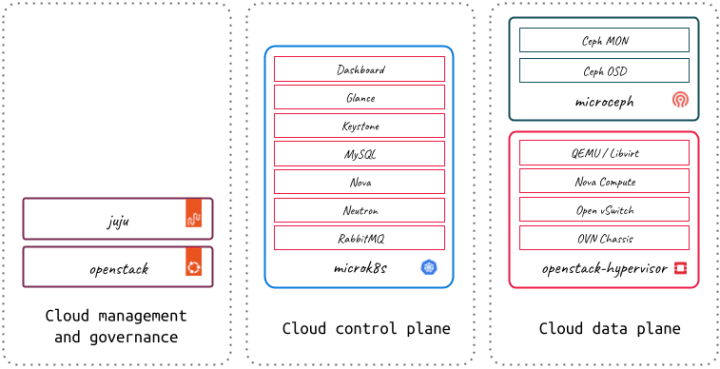Cloud-native infrastructure – When the future meets the present
Tytus Kurek
on 12 January 2024
Tags: cloud-native , containers , Infrastructure , Private cloud , Snaps , Sunbeam
We’ve all heard about cloud-native applications in recent years, but what about cloud-native infrastructure? Is there any reason why the infrastructure couldn’t be cloud-native, too? Or maybe it’s already cloud-native, but you’ve never had a chance to dive deep into the stack to check it out? What does the term “cloud-native infrastructure” actually even mean?
The more you think about it, the more confusing it gets. We all know that the modern way to build infrastructure is to turn it into a cloud. But then, how can a cloud itself be cloud-native or… native to itself? If this sounds tricky, don’t worry – you’re in the right place. Keep reading to see what happens when the future of infrastructure meets the present.
Cloud-native building blocks
Before we start exploring cloud-native infrastructure, let’s make sure we have a common understanding of the concept of cloud-native itself. According to the official definition maintained by the Cloud Native Computing Foundation (CNCF), cloud-native is a set of technologies that “empower organisations to build and run scalable applications in modern, dynamic environments”.
A lot of buzzwords but not many technical details. Fortunately, the CNCF definition also highlights some sample building blocks of cloud-native applications. Those are:
- Containers – package applications’ code together with their dependencies and run them in isolation inside of their runtime environment
- Service meshes – control service-to-service communication with a centrally configurable network of proxies
- Microservices – turn applications into small independent services that communicate with each other through well-defined APIs
- Immutable infrastructure – shifts service management paradigm from the one where components are changed to the one where they are replaced
- Declarative APIs – enable describing the desired application state
While the definition does not force cloud-native application developers to use all these components, the majority of cloud-native applications usually follow this pattern. But can we apply the same approach to the underlying infrastructure as well?

It all starts with cloud-native
It’s easier when you’re operating in the applications space. The infrastructure is already there, providing all the capabilities you need, like container runtimes, rollback mechanisms and more. But what if you’re operating in an environment where the underlying infrastructure is yet to be built, for instance in the private cloud space?
Underneath every cloud is nothing more than a pool of bare metal resources. A cluster of physical machines equipped with CPUs, RAM and disks. What turns this raw infrastructure into a fully functional cloud is the cloud management software. And there is no single reason why this software couldn’t be cloud-native, too.
When the cloud becomes an app
Greatly simplified, the cloud itself is just another app. It installs directly on metal and provides functions to tenant applications running on top. Putting it this way, whether it’s cloud-native or not depends on how the cloud management software is implemented underneath. Porting its architecture on the components listed above effectively sets the foundation for cloud-native infrastructure.
First, we can decompose the cloud management software into several microservices. In fact, leading cloud platforms, such as OpenStack, already follow this pattern. Then, we can run each of those microservices inside immutable containers. Both Kubernetes (K8s) and snapd are suitable for this purpose. Finally, declarative APIs enable high-level abstraction. Instead of struggling with the configuration of individual containers, we can just declare the desired state of the cloud.
Cloud-native infrastructure is an ideal answer for organisations looking for a future-proof cloud platform that will run on their premises. While adopting a hybrid multi-cloud architecture with a private cloud enables them to achieve cost optimisation, digital sovereignty and performance goals, using cloud-native principles enables them to operate it effectively. This way, the cloud management software simply becomes yet another application in their modern, containerised ecosystem, flattening the learning curve and increasing DevOps efficiency.
Let’s have a look at how it works in practice.
Sunbeam – cloud-native infrastructure implementation example
A perfect example of cloud-native infrastructure implementation is Sunbeam.
Sunbeam is an upstream OpenStack project that revolutionises the way users deploy and operate clouds. Its architecture is entirely based on the components that define the cloud-native paradigm. By containerising OpenStack’s control plane and running it on top of K8s, Sunbeam effectively turns OpenStack into an extension to Kubernetes. This way, the K8s cluster gets additional functionalities, such as traditional infrastructure-as-a-service (IaaS) capabilities, which are not natively available in its ecosystem by default.
The architecture of Sunbeam is depicted in the diagram below:

With Sunbeam, all cloud management software components that require hardware access are delivered as snaps. This includes cloud management and governance services, the Kubernetes cluster and hypervisor and storage functions provided by data plane services. This approach ensures a high level of security thanks to the isolation and strict confinement provided by snapd. In turn, all services that don’t require hardware access run on top of K8s as OCI images. This mostly includes cloud control plane services.
All the pieces of the stack are wrapped with charmed operators. A declarative API in front of them enables a high level of abstraction. This way, the initial deployment of the cloud gets significantly simplified, while its post-deployment operations, such as the enablement of plugins, become fully automated.
Learn more
Download our e-book to learn more about Sunbeam and how you can turn OpenStack and Kubernetes into cloud-native apps.
Read more blogs about cloud-native and Sunbeam.
Get in touch with Canonical cloud experts.
Further Reading
Learn more about Canonical’s open source infrastructure solutions.
Microcloud. Same great performance.
Deploy highly available, secure, and dense microcloud environments anywhere, with a lightweight cloud infrastructure that’s designed for the edge.
Newsletter signup
Related posts
OpenStack PoC? No problem!
Setting up a proof of concept (PoC) environment is often one of the first steps in any IT project. It helps organizations to get to grips with the technology,...
OpenStack with Sunbeam for medium-scale cloud infrastructure
The rapid growth in OpenStack installation and orchestration tools that we have seen in recent years has effectively established OpenStack as the world’s...
How telco companies can reduce 5G infrastructure costs with modern open source cloud-native technologies
5G continues to transform the telecommunications landscape, enabling massive device density, edge computing, and new enterprise use cases. However, operators...
